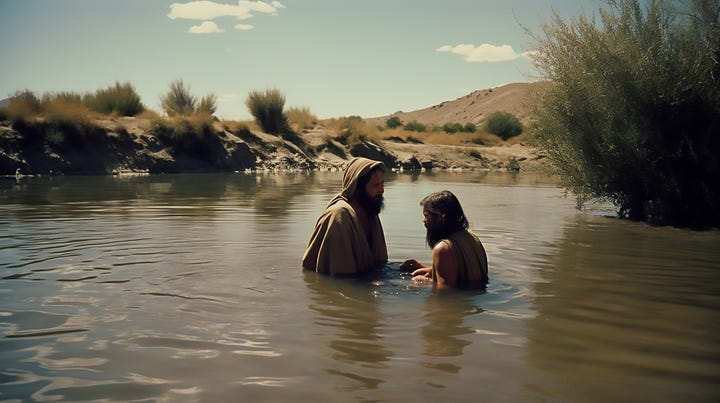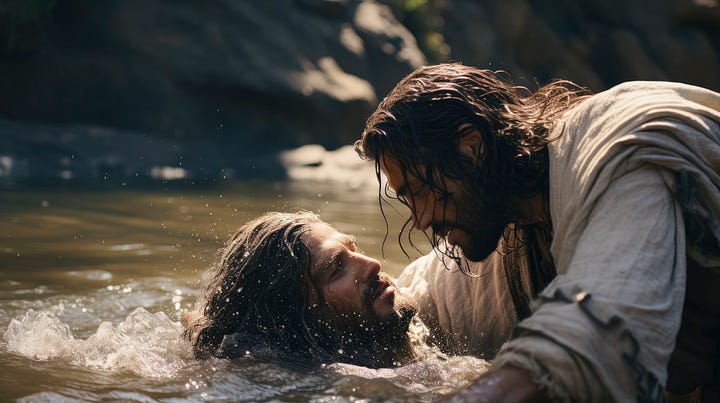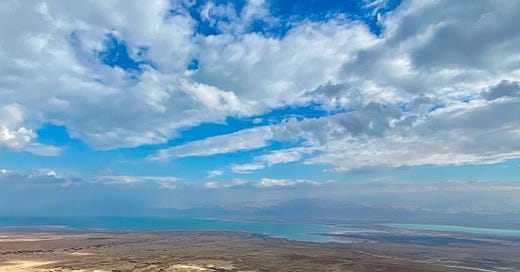Believer’s Baptism? Infant Baptism? Re-Baptism? Dipped? Dunked? Dabbed? Drizzled? We’ve Been Asking the Wrong Question.
The True Meaning of Baptism Isn’t About What We Do--It's about What He Did
Two Lowlifes
The spot where Jesus was baptized is just a bit north of the lowest place on Earth, the Dead Sea, which shares nearly the same staggering elevation—1,200 feet below sea level. On one of my trips there, I led a group of pilgrims to the Salt Sea (Genesis 14:3) for a swim. Of course, you don’t really swim in the Dead Sea. The water is so saturated with salts and minerals, carried down by the rivers and streams that flow into this ultimate stopped-up drain, that you simply float.
On this particular occasion, it was late in the day. Most of the group had left the Sea and headed for the showers, leaving just the two of us—Richard and me— drifting on the water. There we were, floating like flotsam and jetsam on the surface of the lowest surface on Earth.
I looked around. The surrounding hills were silent, and the sea itself lifeless. Nothing grows there. Nothing lives. It is all refuse, the end of the line for everything that flows into the biggest clogged drain on earth.
I turned to Richard, who was reclining effortlessly on the water like a leaf on a pond and said, “Hey, Rich. Look around. I can’t see another living soul. That means, right now, you and I are the lowest forms of life on the planet.”
And yet, it is here on the lowest place on the planet, that the story of Jesus’ baptism begins.
Jesus’ Baptism
For centuries, Christians have debated the correct way to baptize. Should it be by immersion, where the person is fully submerged? Or by sprinkling, where water is gently cast on the head? Or perhaps pouring, symbolizing the outpouring of the Holy Spirit? Entire denominations have been formed around these questions. Yet, I believe we’ve been asking the wrong question all along.
The true question is not how we are baptized but why. And more importantly, how far did Jesus go to make baptism meaningful for us? Let’s journey to the muddy waters of the Jordan River, where it all began.
At the Bottom of the World
The Jordan River is not what you might picture in a postcard-perfect image of pristine water flowing through an untouched wilderness. It is muddy, murky, and profoundly ordinary. By the time it reaches its lowest point near the Dead Sea, it’s a literal drain—the lowest spot on Earth where everything around it flows downward.
This was where John the Baptist set up his ministry. Thousands came to hear his fiery sermons and to take part in a revival of repentance. They waded into the muddy waters, confessing their sins, shedding their guilt, and washing themselves, letting the river carry it all downstream. The Jordan became a basin of brokenness—a place where human sorrow and repentance pooled in its depths.
And then, one day, Jesus came.
Why Did Jesus Choose the Jordan?
The moment Jesus stepped into the Jordan, it must have stunned the crowd. This was the man John had been proclaiming as “the Lamb of God, who takes away the sin of the world.” He needed no repentance. Yet, He did not hesitate to join the sinners in the water. Why?
There are many reasons theologians have debated, but let’s focus on the one that stands out the most: Jesus’ baptism was a declaration that there is no place too low for Him to go. He chose the Jordan because it represented the depths of humanity’s brokenness. The tears of the penitent, the dirt of the downtrodden, the weight of generations of sin—it all flowed into that muddy water. And Jesus stepped right into it.


How Low Did He Go?
Imagine being there that day. The crowd was a mix of the curious, the desperate, and the devout. Some had come out of fear of missing out, others sought a fresh start. John’s preaching spared no one: the religious elite were called a “brood of vipers,” while the common folk were urged to live with integrity—sharing their wealth, ceasing exploitation, and being content with what they had. His message was clear: repent, for the kingdom of heaven had come near.
And then Jesus walked into the water.
Of course, we know that Jesus didn’t have to walk into the water. It was only a matter of time before He showed He could walk on the water. But He came down to the place of washed out sins to demonstrate to every sinner that He would immerse Himself in their sorrow, tears, sins, and sadness. He went deeper than they would ever have to go.
The heavens opened. The Spirit descended like a dove. A voice declared, “This is my beloved Son, in whom I am well pleased.” In that moment, the ordinary became extraordinary. The muddy waters of the Jordan became a holy place, not because of their purity—they were cleaned by their repentance—but because of His presence. I’ve heard some say that a person must be immersed to show they are fully new—whatever gets wet gets renewed. But that isn’t what is happening in the Jordan. What’s happening is that the Lord is fully identifying Himself with everyone whose sins was confessed and washed off.
When we think about baptism today, we often focus on how far we must go. Should we be fully immersed to symbolize burial and resurrection? Should we be sprinkled or poured over as a sign of cleansing? But the story of Jesus’ baptism flips that question on its head. It’s not about how far we go—it’s about how far He went.
The Jordan River, the lowest geographical point on Earth, becomes a symbol of Christ’s descent into our humanity. He didn’t just touch the surface of our brokenness; He plunged into the depths of our sorrow, sin, and shame. His baptism foreshadowed the cross, where He would descend even further, taking on the full weight of humanity’s sin.
Was there any part of you He didn’t reach? Any corner of your pain, regret, or shame He left untouched? No. Jesus’ baptism declared that He meets us at our lowest so that He might lift us into the heights of God’s love.
If Jesus can’t get down to where you’ve descended to, then He’s not the Savior you need. But He is because He did.
When you think about baptism, don’t focus on the mode. Focus on the meaning. It’s not about how far you need to go; it’s about how far He went. And the answer is this: all the way down.
The Rev. David Roseberry, an ordained Anglican priest with over 40 years of pastoral experience, offers leadership services to pastors, churches, and Christian writers. He is an accomplished author whose books are available on Amazon. Rev. Roseberry is the Executive Director of LeaderWorks, where his work and resources can be found.





